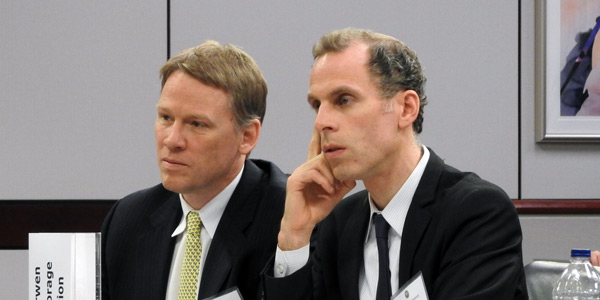By Rory D. Sweeney
WASHINGTON — Despite its virtues, energy storage won’t eliminate the need to pay unprofitable generators to continue operating for grid support, speakers said in the second panel of FERC’s technical conference on storage Wednesday.
In its notice of the conference (AD16-25), FERC noted that storage resources are modular and easily transportable — meaning they could provide local voltage support in situations that would otherwise result in contracts with generators as reliability-must-run (RMR) or system support resources. Building transmission to alleviate such problems following a plant retirement often takes years.
But grid operators questioned whether storage will be a cheaper option.
“It’s going to be very difficult for any new resource to compete with [a generating plant] that’s already essentially heavily depreciated,” said Neil Millar, CAISO’s executive director of infrastructure development. “I just think we need to be realistic about expectations.”
Eric Hsia, PJM’s manager of performance compliance, was also skeptical. “I totally agree that markets for storage are good things and what we should be focused on, but we know these RMRs are going to continue to get done and they’re not going to go away necessarily,” he said.
Representatives of CAISO, PJM and NYISO said they all recover RMR contract costs in the zones that will eventually pay for the necessary transmission upgrade and not as part of region-wide transmission rates.
Lead Time

Witnesses also questioned whether storage could be implemented quickly enough to replace RMRs.
Capacity Performance units in PJM are required to give three years’ notice in advance of retirements, but non-CP units only need to give 90 days.
That might not be enough time to get storage in place, said Bill Capp, president of Grid Storage Consulting.
Millar said nine months is the fastest deployment he’s seen and that included several implementation teams working in parallel. “If we’re talking a smaller battery storage project, like sub-transmission, the ability to interconnect that project more quickly is higher,” he said, but for larger installs, “months is very tight.”
He said CAISO is identifying areas where future retirements will likely create reliability issues and is developing plans to address the potential.
Michael DeSocio, senior manager of market design for NYISO, said running a competitive process for such situations “extends the timeframe … because it’s going to take us longer to go through all the projects to figure out reliability and sufficiency and what we can deal with.”
“Not a bad idea,” DeSocio added. “Just it will add time to the process.”
Little Experience

Grid operator representatives acknowledged they haven’t had much experience with such projects. Millar was the only one who provide an example, saying about 110 MW of storage will be used to respond to the closure of the Aliso Canyon natural gas storage facility. “That was probably the most expedited procurement of storage we’ve seen,” he said.
The California Public Utilities Commission ordered the procurement in August, and projects are required to be completed by Dec. 31.
Part of the issue, developers said, is that the grid operators aren’t prepared to handle the flexibility of storage, so developers haven’t made the effort to propose projects.
“I think generally speaking, most of your ISOs/RTOs right now have an open-mindedness toward storage as a non-transmission alternative,” said John Fernandes of Renewable Energy Systems Americas. “Not everyone might be far enough along to do the complex modeling that’s needed to optimize the system. … I think there’s possibly a little bit of a disconnect between ‘sure, we’ll go in to take a look’ and ‘yes, we will actually deploy this.’ Until the developer community has some level of certainty that there is at least some likelihood that non-transmission alternatives will be selected, it’s hard for us to justify spending the time, the resources, the effort to really put together viable projects.”
Getting the Green Light
Storage isn’t likely to get special consideration from operators. “Looking at all the variables, if energy storage meets that cost, the lowest methodology, that’s fine if we go with energy storage. But if some other technology can meet the same solution at a lower cost, then we would favor that,” said Charlie Bayless, of the North Carolina Electric Membership Corp., who represented the National Rural Electric Cooperative Association.
“A competitive process is of interest if we can, one, agree on a manner in which it is able to happen expeditiously, but also two, we should be looking at this as a manner that is in fact adding value by reducing the costs of this particular solution to the system,” said Jason Burwen of the Energy Storage Association.
“We’re looking to compete at cost with all the other resources being considered,” Fernandes said. “[We’re] not looking to shoulder ratepayers with a neat little experiment here. We’re justifying this in front of regulators everywhere.”
However, storage needs to be able to serve multiple functions to make it economical, he said. The single RMR revenue stream is insufficient. “I might also want to participate in the real-time market at certain times,” he said.






